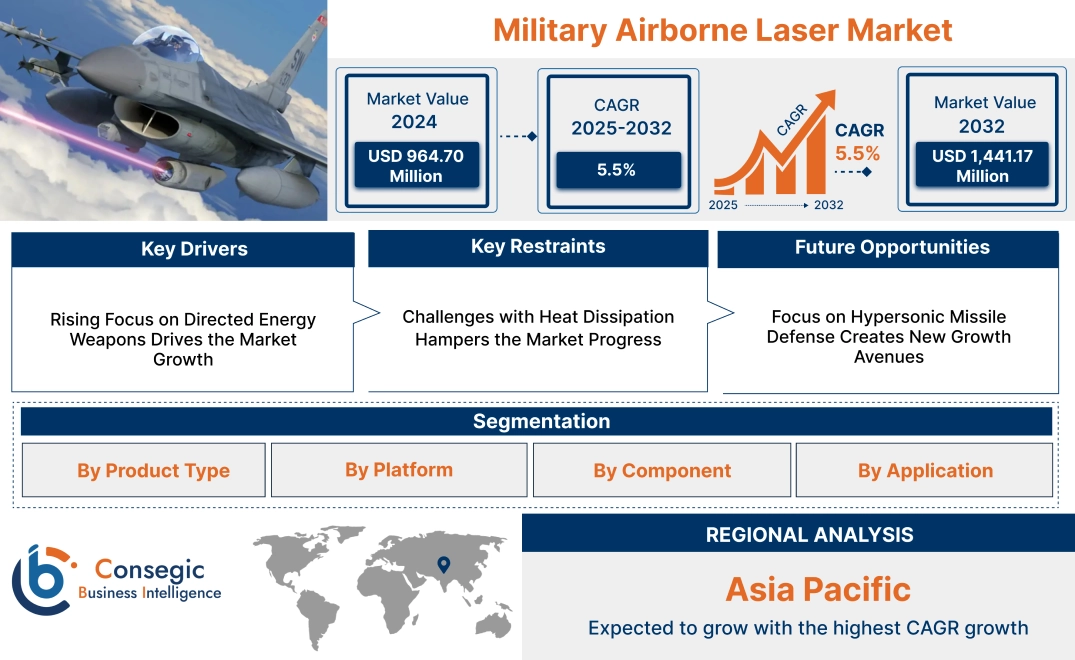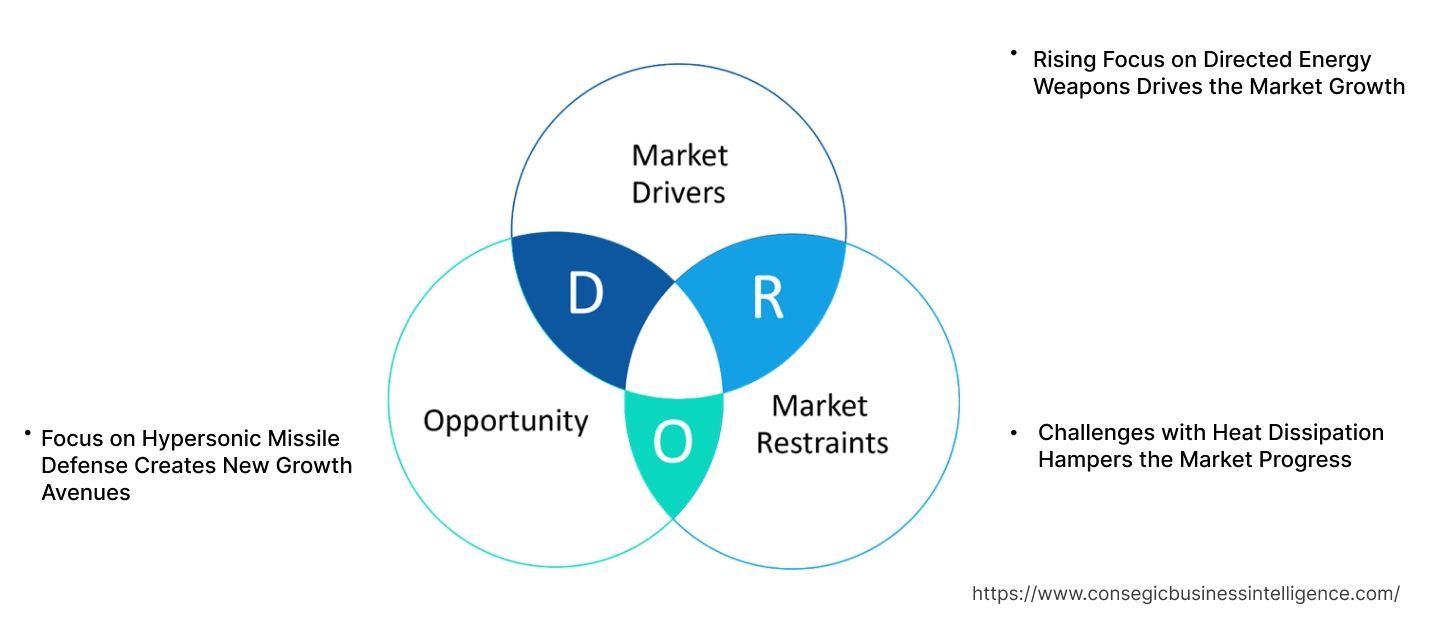- Summary
- Table Of Content
- Methodology
Military Airborne Laser Market Size:
Military Airborne Laser Market size is estimated to reach over USD 1,441.17 Million by 2032 from a value of USD 964.70 Million in 2024 and is projected to grow by USD 997.56 Million in 2025, growing at a CAGR of 5.5% from 2025 to 2032.
Military Airborne Laser Market Scope & Overview:
Military airborne lasers are advanced directed energy systems deployed on aircraft to perform a variety of tasks, including target designation, missile defense, and precision engagement. These systems use laser technology to deliver high-energy beams capable of neutralizing threats, providing enhanced capabilities for modern military operations. They are designed to operate effectively in dynamic combat environments, offering speed, precision, and scalability.
These lasers are integrated with sophisticated targeting systems, sensors, and avionics to ensure accuracy and reliability during missions. They are capable of engaging both airborne and ground-based threats, making them versatile for a wide range of applications. Built for durability and efficiency, these systems are engineered to function in challenging operational conditions, including high altitudes and adverse weather.
End-users include air forces, defense organizations, and aerospace manufacturers focused on advancing military capabilities with cutting-edge technology. Military airborne lasers play a crucial role in modernizing defense strategies and ensuring mission success in complex operational scenarios.
Key Drivers:
Rising Focus on Directed Energy Weapons Drives the Market Growth
Rising interest in directed energy weapons has positioned airborne lasers as a critical component in modern defense strategies. These systems enable precision targeting, rapid response, and efficient threat interception, making them ideal for countering emerging threats like drones, missiles, and other aerial hazards. Unlike traditional weaponry, airborne lasers provide cost-effective and scalable solutions, minimizing collateral damage while ensuring mission success. Their ability to neutralize multiple targets in real time enhances their appeal for both defensive and offensive military operations. Investments in laser-based systems are further driven by their adaptability to various platforms, including combat aircraft and UAVs, ensuring operational versatility. As defense forces prioritize advanced, precision-driven technologies, airborne lasers are emerging as a preferred choice for securing airspace and enhancing national defense capabilities. This growing focus on directed energy weapons is shaping the future of military engagements and driving innovation in laser technology, further boosting the military airborne laser market growth.
Key Restraints:
Challenges with Heat Dissipation Hampers the Market Progress
High-energy laser systems used in military applications face significant issues with heat dissipation. The intense energy output required for effective operation generates substantial heat, which, if unmanaged, reduces system performance and longevity. To counter this, advanced cooling mechanisms, such as liquid cooling systems or specialized heat sinks, are necessary to maintain operational efficiency and prevent overheating. However, these cooling solutions add to the complexity of the system design, increasing both the size and weight of the equipment, which limit its integration into certain platforms like smaller aircraft or UAVs.
Additionally, the costs associated with developing and maintaining these advanced cooling systems restrict their adoption in budget-sensitive defense programs, further limiting the military airborne laser market demand. These constraints with heat dissipation not only impact deployment feasibility but also emphasize the need for ongoing research into more efficient thermal management solutions for high-energy laser technologies.
Future Opportunities :
Focus on Hypersonic Missile Defense Creates New Growth Avenues
The rapid development of hypersonic missile technologies, which travel at speeds exceeding Mach 5, has significantly heightened the demand for advanced defense solutions. High-energy laser systems are emerging as a critical component in countering these threats due to their ability to engage targets with precision and speed. Unlike traditional defense systems, lasers can provide near-instantaneous response times, making them ideal for intercepting maneuverable hypersonic projectiles. Defense organizations are increasingly investing in next-generation laser technologies designed specifically for hypersonic missile defense, focusing on systems with enhanced range, power output, and target-tracking capabilities. These investments aim to strengthen national security by equipping militaries with reliable tools to neutralize advanced aerial threats. As the hypersonic missile race intensifies globally, the focus on laser-based interception solutions continues to grow, driving technological innovation and creating new military airborne laser market opportunities.
Military Airborne Laser Market Segmental Analysis :
By Product Type:
Based on product type, the market is categorized into LIDAR, 3D scanning, laser weapon, laser range finder, and laser altimeter.
The laser weapon segment accounted for the largest revenue of the total military airborne laser market share in 2024.
- Laser weapons provide precision targeting and cost-efficient interception of airborne threats, enhancing military operational capabilities.
- The increasing adoption of laser weapons for missile defense and countermeasure applications underscores their significance in modern warfare.
- Advanced laser weapon systems are favored due to their reduced collateral damage and high accuracy in target engagement.
- The segment’s dominance reflects the growth in investments towards directed energy weapons by defense organizations globally, contributing to the military airborne laser market expansion.
The LIDAR segment is projected to register the fastest CAGR during the forecast period.
- LIDAR systems are increasingly used for terrain mapping, obstacle detection, and navigation in challenging environments.
- The growth in integration of LIDAR in unmanned aerial vehicles (UAVs) supports its rapid adoption for military reconnaissance.
- Advancements in LIDAR technology, including improved resolution and range, drive its demand in tactical operations.
- As per the military airborne laser market analysis, emerging applications in 3D mapping and surveillance further fuel the growth of the LIDAR segment.
By Platform:
Based on platform, the market is segmented into fixed-wing aircraft, rotary-wing aircraft, and unmanned aerial vehicles (UAVs).
The unmanned aerial vehicles (UAVs) segment held the largest revenue of 40.53% of the total military airborne laser market share in 2024.
- UAVs equipped with advanced laser systems are widely used for surveillance, target designation, and precision strikes.
- The operational flexibility and cost-effectiveness of UAVs enhance their adoption for military applications.
- Increased deployment of UAVs in combat zones reflects the growing importance of autonomous platforms in modern warfare.
- As per market analysis, UAVs' ability to operate in high-risk environments supports their dominance in the market, further encouraging the military airborne laser market growth.
The fixed-wing aircraft segment is anticipated to exhibit the fastest CAGR during the forecast period.
- Fixed-wing platforms are being upgraded with sophisticated laser systems for long-range reconnaissance and targeting.
- Their suitability for missile defense and countermeasure applications drives investments in laser-equipped fixed-wing aircraft.
- Enhanced endurance and operational range of fixed-wing platforms further boost their role in strategic defense missions.
- As per the military airborne laser market trends, technological advancements in laser integration on fixed-wing aircraft accelerate their adoption across defense operations.
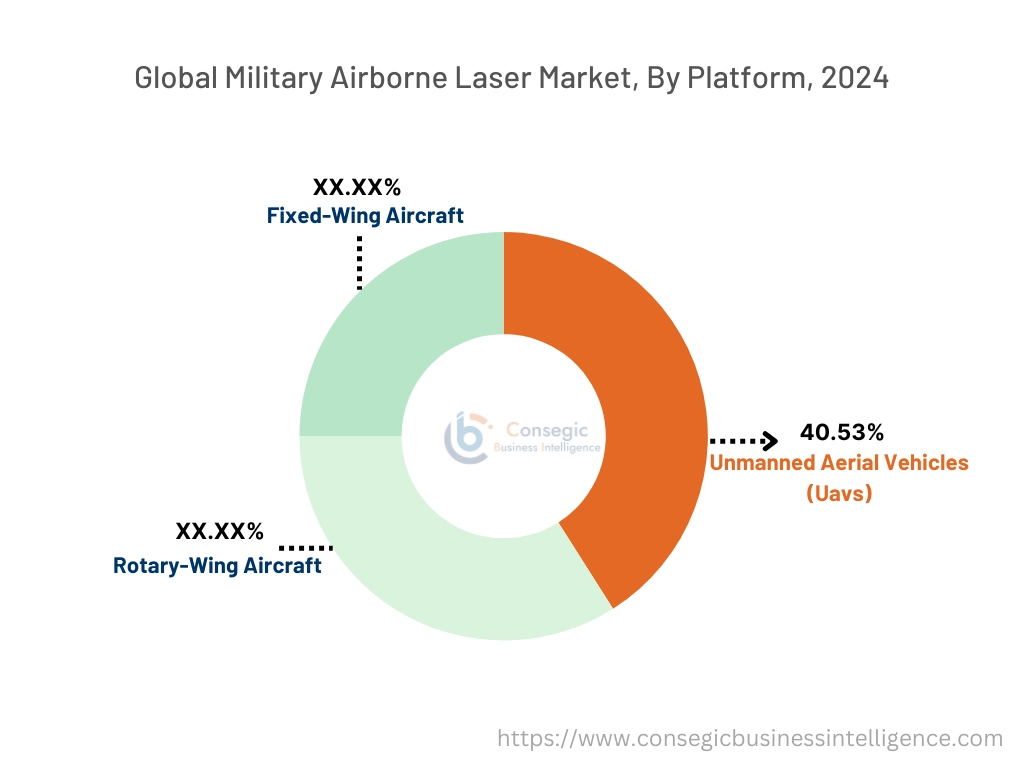
By Component:
Based on component, the market is divided into laser source, beam director, power supply, cooling system, control system, and others.
The laser source segment accounted for the largest revenue share in 2024.
- High-performance laser sources are critical for achieving the precision and range required in military operations.
- Continuous advancements in laser diode technologies enhance the efficiency and reliability of laser sources.
- The dominance of this segment reflects the essential role of laser sources in enabling diverse applications, including targeting and navigation.
- As per industry analysis, increasing defense budgets worldwide support the procurement of advanced laser source systems, fueling the military airborne laser market demand.
The cooling system segment is projected to grow at the fastest CAGR during the forecast period.
- Efficient cooling systems are pivotal for maintaining the performance and longevity of high-power laser systems.
- The adoption of innovative cooling technologies, such as liquid cooling, supports the reliability of laser components in combat scenarios.
- Increased demand for compact and energy-efficient cooling solutions drives advancements in this segment.
- Thus, emerging trends indicate growing investments in cooling systems to enhance the operational efficiency of laser-equipped platforms, driving the military airborne laser market expansion.
By Application:
Based on application, the market is segmented into target designation, missile defense, rangefinding, countermeasure systems, and others.
The missile defense segment held the largest revenue share in 2024.
- Laser systems are increasingly deployed for intercepting and neutralizing ballistic missile threats with precision.
- Growing investments in advanced missile defense programs highlight the strategic importance of laser technologies.
- High-energy laser systems offer real-time threat engagement, enhancing the security of military installations.
- As per the military airborne laser market analysis, the segment's dominance reflects the critical role of missile defense systems in modern military strategies.
The target designation segment is expected to register the fastest CAGR during the forecast period.
- Advanced laser systems enable precise target identification and illumination in complex battlefield environments.
- Increasing integration of target designation systems in UAVs and rotary-wing aircraft supports their rapid adoption.
- As per market trends, advancements in laser target designators enhance their accuracy and operational efficiency.
- Thus, emerging defense requirements for multi-role platforms accelerate the adoption of laser-based target designation systems, creating significant military airborne laser market opportunities.Bottom of Form
Regional Analysis:
The regions covered are North America, Europe, Asia Pacific, the Middle East and Africa, and Latin America.
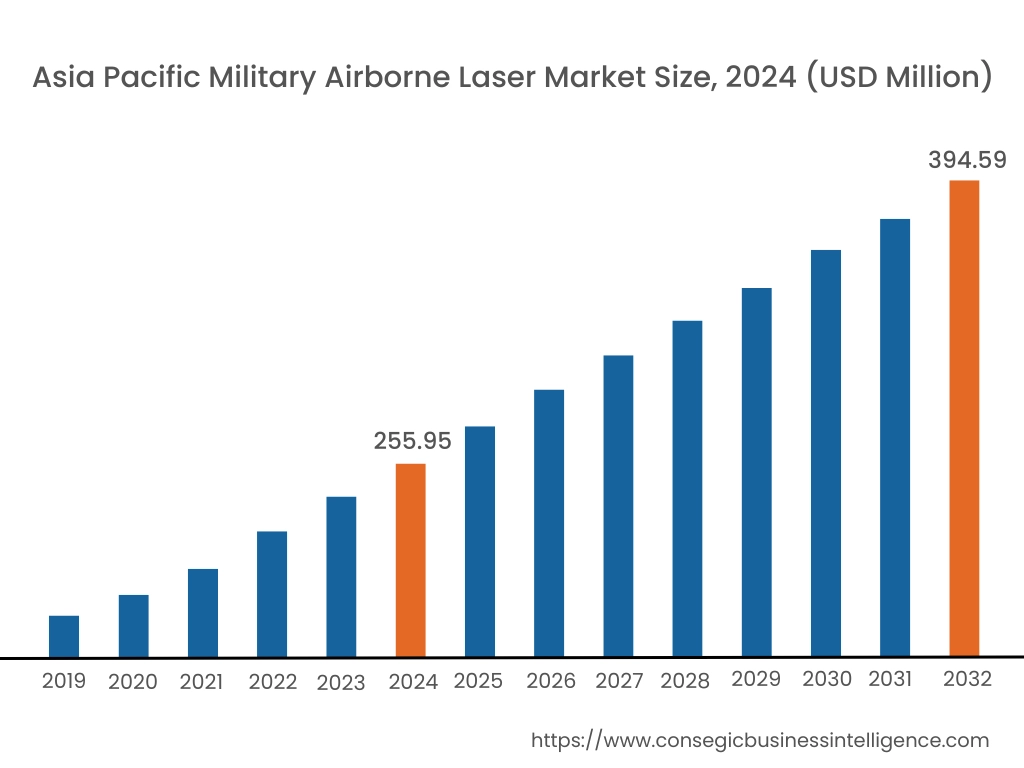
Asia Pacific region was valued at USD 255.95 Million in 2024. Moreover, it is projected to grow by USD 265.37 Million in 2025 and reach over USD 394.59 Million by 2032. Out of this, China accounted for the maximum revenue share of 35.1%. The Asia-Pacific region is witnessing a surge in demand for military airborne lasers, propelled by increasing defense expenditures and the induction of advanced military aircraft. Countries such as China, India, and Japan are focusing on integrating laser systems to enhance their defense capabilities. A prominent trend is the development of indigenous laser technologies to reduce reliance on foreign suppliers. Analysis suggests that regional security dynamics and technological advancements are key factors influencing the market in this area.
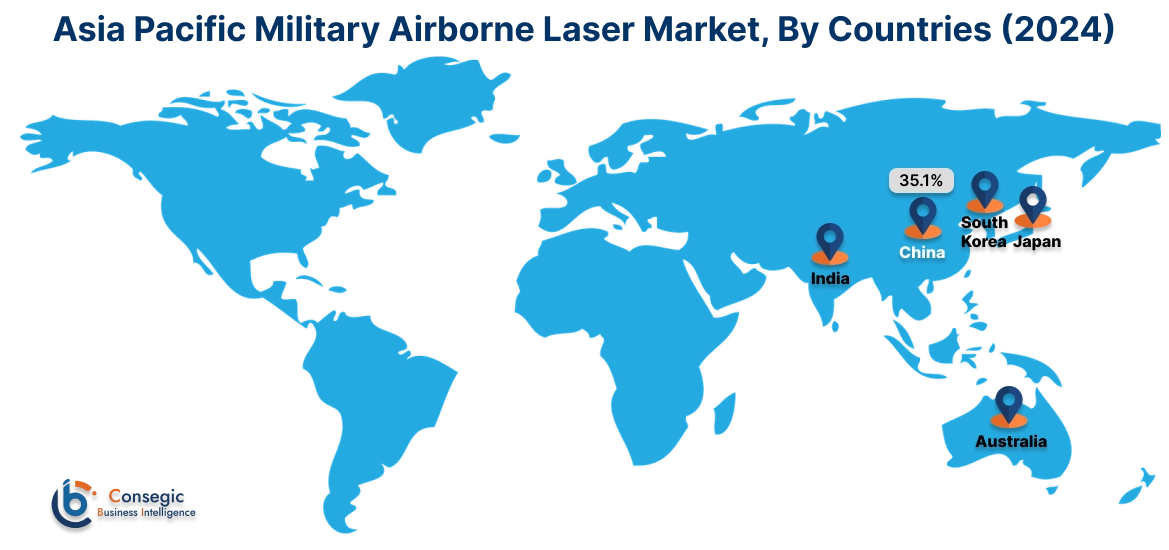
North America is estimated to reach over USD 459.45 Million by 2032 from a value of USD 309.82 Million in 2024 and is projected to grow by USD 320.17 Million in 2025. This region holds a substantial share of the military airborne laser market, driven by the United States' emphasis on enhancing defense capabilities through advanced technologies. The integration of high-energy laser systems into military aircraft is a notable trend, aiming to provide precise targeting and improved operational efficiency. Analysis indicates that ongoing investments in research and development, coupled with modernization programs, are pivotal in shaping the market landscape in North America.
European nations, including the United Kingdom, France, and Germany, are actively investing in military airborne laser technologies to bolster their defense systems. A significant trend is the collaboration among European defense manufacturers to develop sophisticated laser solutions tailored for various military applications.
In the Middle East, nations are prioritizing the enhancement of their military capabilities, leading to investments in airborne laser systems. The focus is on equipping existing and new military aircraft with advanced laser technologies to mitigate risks during operations. However, political instability and economic diversification efforts in certain areas may impact market dynamics. In Africa, the market is gradually evolving, with a focus on addressing challenges related to defense modernization. Analysis indicates that international collaborations and capacity-building initiatives are playing a crucial role in enhancing military capabilities across the continent.
Latin American countries are increasingly recognizing the importance of military airborne lasers in ensuring the effectiveness of their defense forces. As per the military airborne laser market trends, nations such as Brazil and Mexico are investing in laser technologies to modernize their military aviation capabilities. A notable trend is the emphasis on procuring cost-effective solutions that offer reliable performance.
Top Key Players and Market Share Insights:
The Military Airborne Laser market is highly competitive with major players providing products and services to the national and international markets. Key players are adopting several strategies in research and development (R&D), product innovation, and end-user launches to hold a strong position in the global Military Airborne Laser market. Key players in the Military Airborne Laser industry include -
- Lockheed Martin Corporation (USA)
- Northrop Grumman Corporation (USA)
- Leonardo S.p.A. (Italy)
- Elbit Systems Ltd. (Israel)
- Kratos Defense & Security Solutions, Inc. (USA)
- Raytheon Technologies Corporation (USA)
- BAE Systems (UK)
- Thales Group (France)
- Boeing Company (USA)
- L3Harris Technologies (USA)
Military Airborne Laser Market Report Insights :
| Report Attributes | Report Details |
| Study Timeline | 2019-2032 |
| Market Size in 2032 | USD 1,441.17 Million |
| CAGR (2025-2032) | 5.5% |
| By Product Type |
|
| By Platform |
|
| By Component |
|
| By Application |
|
| By Region |
|
| Key Players |
|
| North America | U.S. Canada Mexico |
| Europe | U.K. Germany France Spain Italy Russia Benelux Rest of Europe |
| APAC | China South Korea Japan India Australia ASEAN Rest of Asia-Pacific |
| Middle East and Africa | GCC Turkey South Africa Rest of MEA |
| LATAM | Brazil Argentina Chile Rest of LATAM |
| Report Coverage |
|
Key Questions Answered in the Report
What is the size of the Military Airborne Laser Market? +
The Military Airborne Laser Market size is estimated to reach over USD 1,441.17 Million by 2032 from a value of USD 964.70 Million in 2024 and is projected to grow by USD 997.56 Million in 2025, growing at a CAGR of 5.5% from 2025 to 2032.
What are the key segments in the Military Airborne Laser Market? +
The market is segmented by product type (LIDAR, 3D Scanning, Laser Weapon, Laser Range Finder, Laser Altimeter), platform (Fixed-Wing Aircraft, Rotary-Wing Aircraft, Unmanned Aerial Vehicles (UAVs)), component (Laser Source, Beam Director, Power Supply, Cooling System, Control System, Others), and application (Target Designation, Missile Defense, Rangefinding, Countermeasure Systems, Others).
Which segment is expected to grow the fastest in the Military Airborne Laser Market? +
The LIDAR segment is projected to grow at the fastest CAGR during the forecast period due to its increasing use for terrain mapping, obstacle detection, and navigation in military operations, especially with UAVs.
Who are the major players in the Military Airborne Laser Market? +
Key players in the Military Airborne Laser market include Lockheed Martin Corporation (USA), Northrop Grumman Corporation (USA), Raytheon Technologies Corporation (USA), BAE Systems (UK), Thales Group (France), Boeing Company (USA), L3Harris Technologies (USA), Leonardo S.p.A. (Italy), Elbit Systems Ltd. (Israel), and Kratos Defense & Security Solutions, Inc. (USA).
